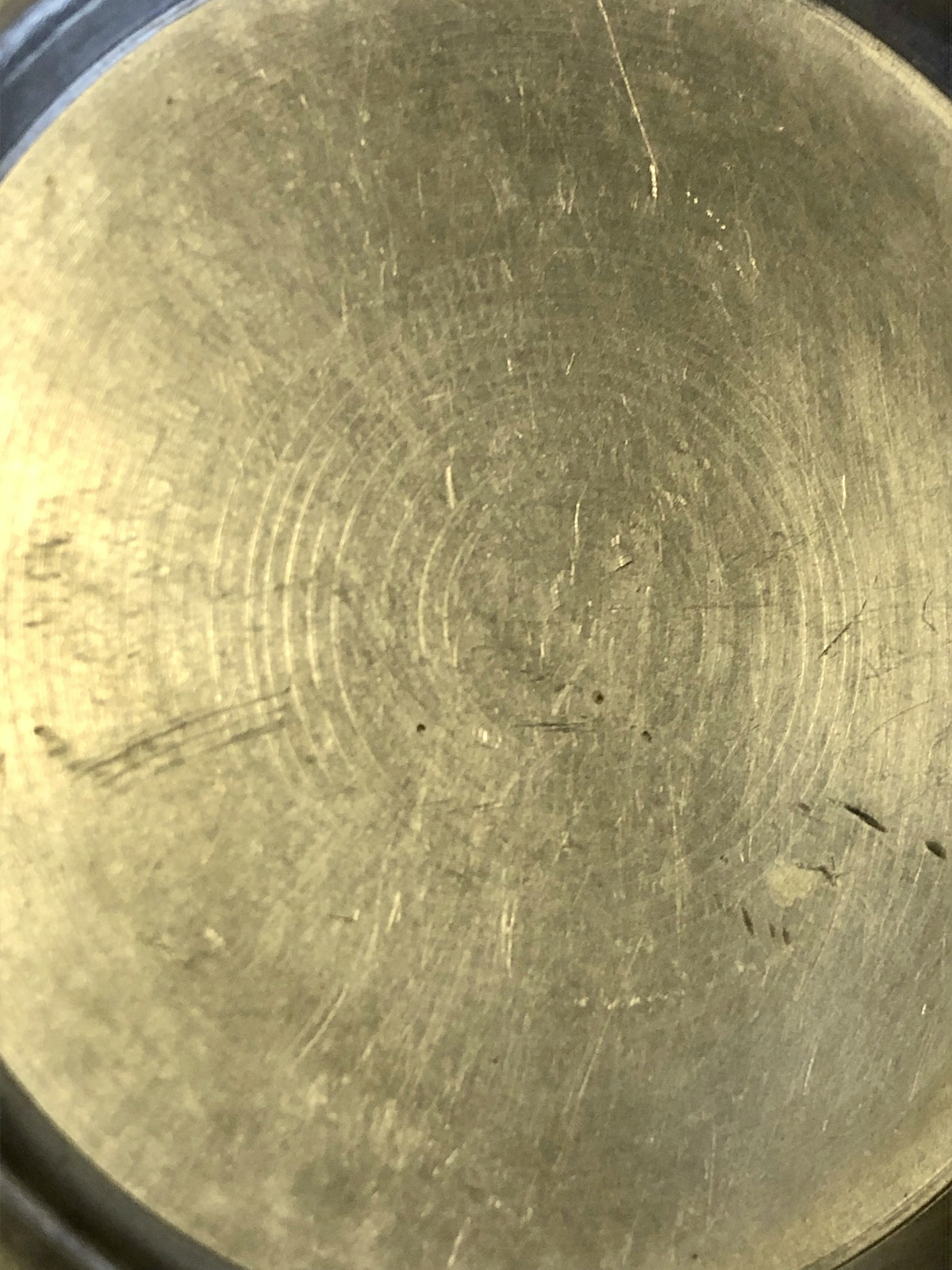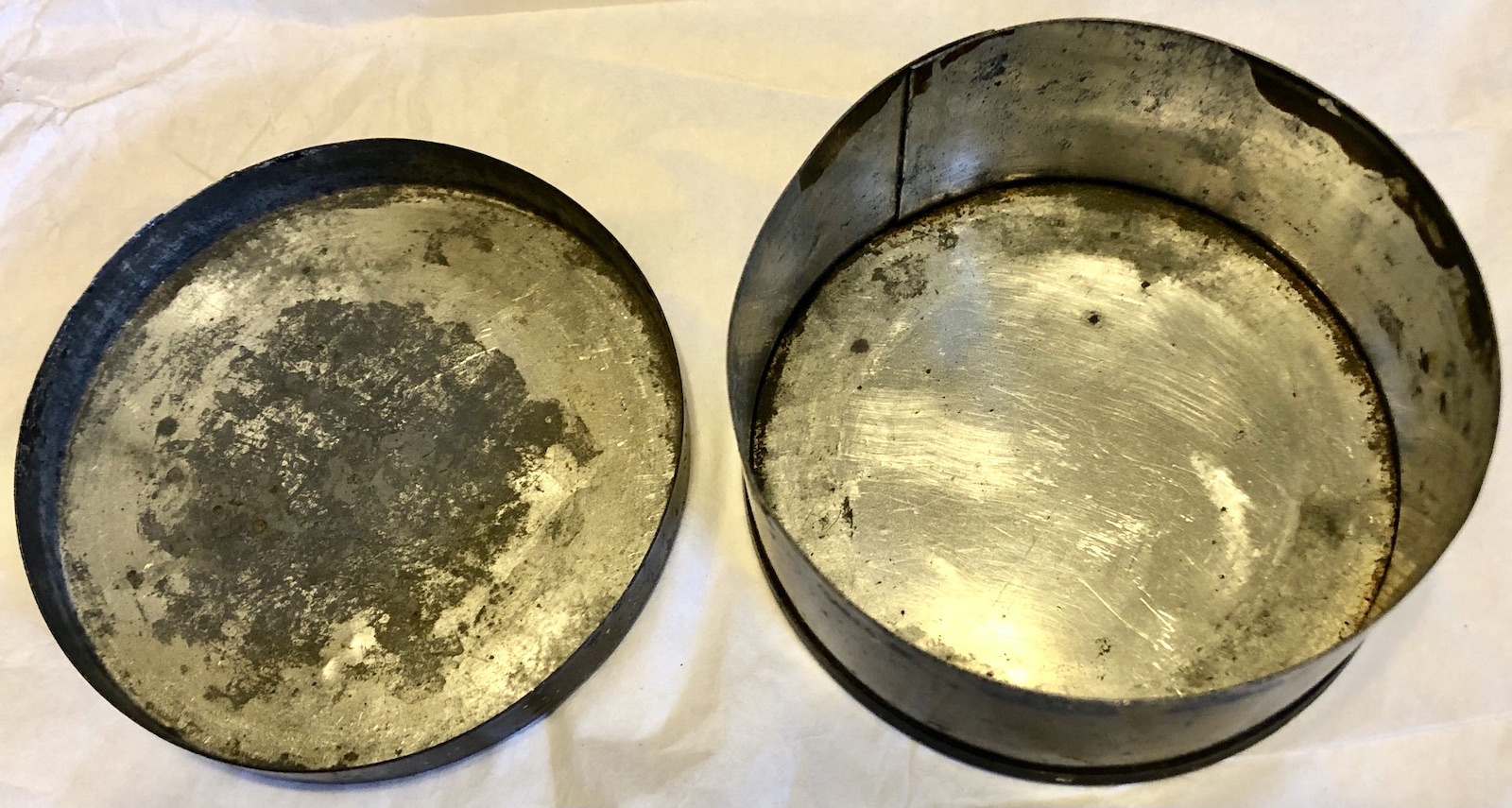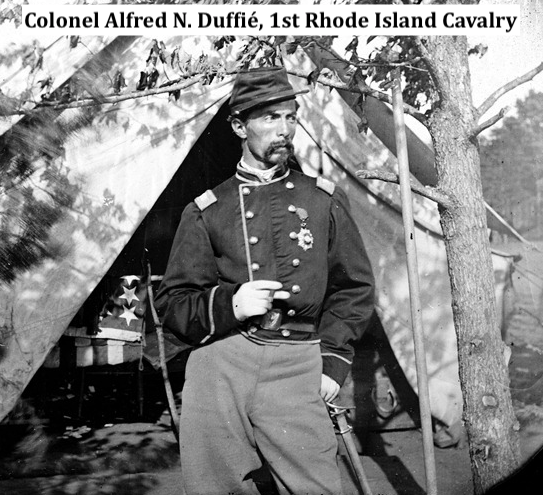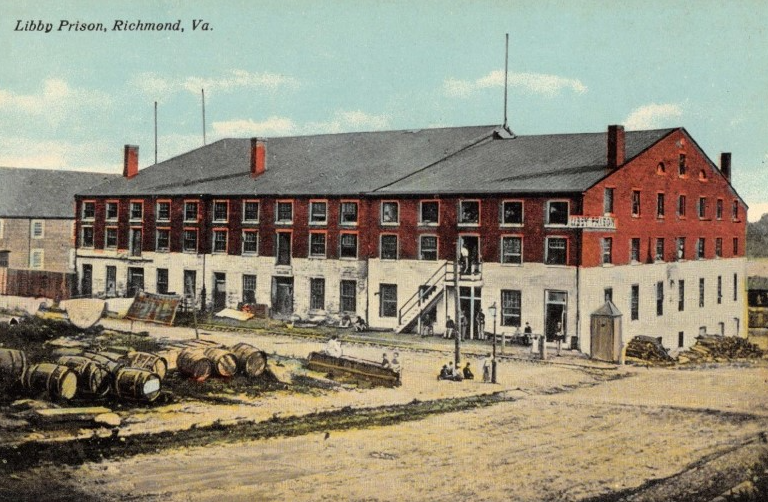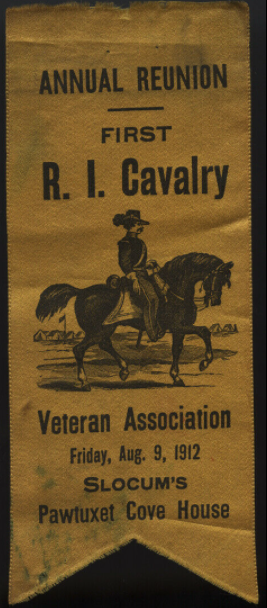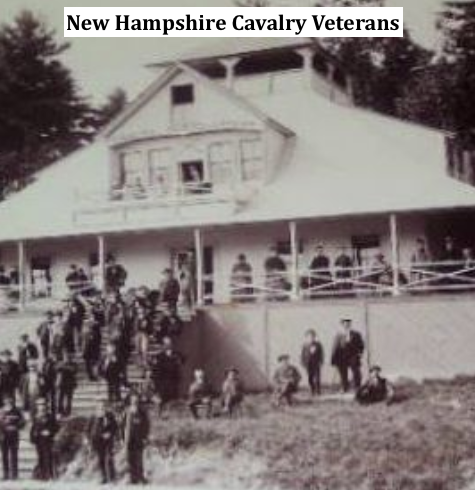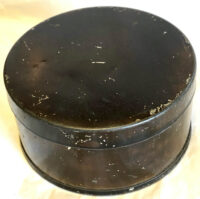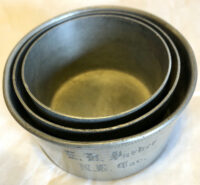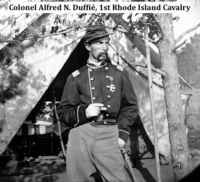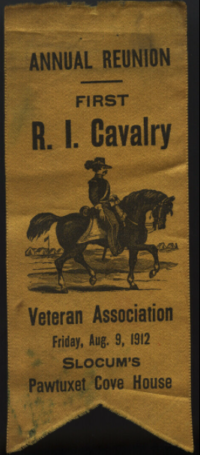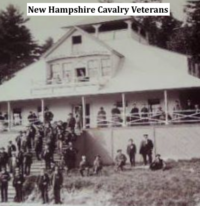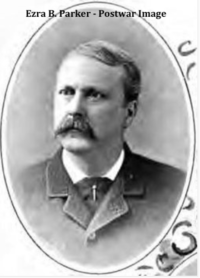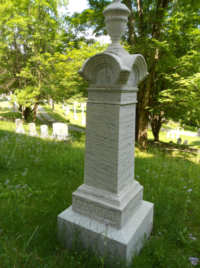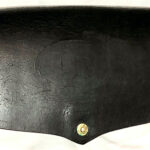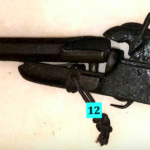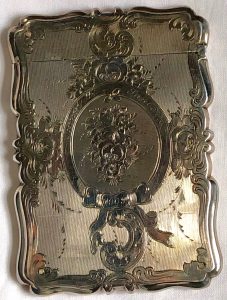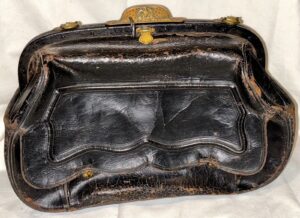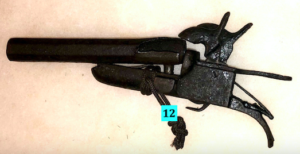Civil War Pewter Collapsible Cup in its Original Japanned Case – Id’d to Capt. Ezra B. Parker, 1st New Hampshire Cavalry – POW at Libby Prison
$750
Civil War Pewter Collapsible Cup in its Original Japanned Case – Id’d to Capt. Ezra B. Parker, 1st New Hampshire Cavalry – POW at Libby Prison – These pewter cups were commonly utilized by Civil War soldiers, especially the well-equipped officers. This example is still housed in its original, japanned, lead soldered, tin container, which remains in excellent condition. The collapsible, telescopic cup, when opened, reveals, on one of the circular components, the following, jeweler engraved name and military designation:
“E. B. Parker
NH Cav”
Captain Parker enlisted, at the onset of hostilities, in the 1st New Hampshire Cavalry, as a First Sergeant and would become a member of the 1st Rhode Island Cavalry, along with the rest of his New Hampshire compatriots. As quoted from the regimental history:
“The First Regiment Rhode Island Cavalry was originally composed of three battalions, two of which were recruited by the State, and one by New Hampshire. This was under a modification of an order of the War Department, dated September 27th, 1861, for the organizing of a Regiment of Cavalry to be composed of companies or squadrons recruited in the New England States. In New Hampshire the squadron of four companies was enlisted under the direction of Colonel Robert B. Lawton. The Regiment was organized in the autumn of 1861 and placed temporarily under the command of Colonel George W. Hallett, subsequently appointed Chief of Cavalry in Rhode Island.”
Parker would serve throughout the bulk of the war, with the 1st Rhode Island, serving on Col. Alfred Duffie’s staff, as an Assistant Inspector General. Parker was captured on June 18, 1863, by the Confederates, at Middleburg, Virginia and confined at Libby Prison, in Richmond, for almost nine months, until being released in May of 1864. By the time of his release, he had been promoted to the rank of Captain. After the war, Parker, who had been a law student prior to his army service, became involved in the mercantile business, in Boston.
This is a superior example of an officer’s collapsible, war-used cup, in its original carrying container; the cup may have accompanied him throughout the war.
Measurements: Cup Height – 3.25″ (fully opened); Cup Diameter – 2.5″ (diameter of largest section)
Ezra B. Parker
| Residence Littleton NH; 23 years old.
Enlisted on 12/6/1861 as a 1st Sergeant.
On 12/27/1861 he mustered into “L” Co. RI 1st Cavalry He was discharged for promotion on 3/31/1864
On 3/31/1864 he was commissioned into Field & Staff NH 1st Cavalry He was Mustered Out on 7/15/1865 at Cloud’s Mills, VA He was listed as: * Absent leave 2/16/1863 (place not stated) (For 15 days) * Detached 3/15/1863 Col Duffie’s Staff As Asst Inspector Gen (Estimated day) * Returned 6/15/1863 (place not stated) (Estimated day) * POW 6/18/1863 Middleburg, VA (Confined at Libby Prison, Richamond, VA) * Released 5/15/1864 (place not stated) (Estimated day) Promotions: * 2nd Lieut 8/4/1862 * Adjutant 12/1/1862 * Capt 3/31/1864 (As of Co. D) Intra Regimental Company Transfers: * 12/1/1862 from company L to Field & Staff * 3/31/1864 from Field & Staff to company D Other Information: born in Littleton, NH After the War he lived in Boston, MA |
| NAME: | Ezra B Parker | ||||||||||||||||
| AGE: | 21 | ||||||||||||||||
| BIRTH YEAR: | 1839 | ||||||||||||||||
| GENDER: | Male | ||||||||||||||||
| BIRTH PLACE: | New Hampshire | ||||||||||||||||
| HOME IN 1860: | Littleton, Grafton, New Hampshire | ||||||||||||||||
| POST OFFICE: | Littleton | ||||||||||||||||
| DWELLING NUMBER: | 576 | ||||||||||||||||
| FAMILY NUMBER: | 623 | ||||||||||||||||
| OCCUPATION: | College Student | ||||||||||||||||
| ATTENDED SCHOOL: | Y | ||||||||||||||||
| HOUSEHOLD MEMBERS: |
|
||||||||||||||||
| NAME: | Ezra B Parker | ||||||||||||||||
| ENLISTMENT AGE: | 23 | ||||||||||||||||
| BIRTH DATE: | 1838 | ||||||||||||||||
| BIRTH PLACE: | Littleton, New Hampshire, USA | ||||||||||||||||
| ENLISTMENT DATE: | 6 Dec 1861 | ||||||||||||||||
| ENLISTMENT RANK: | 1st Sergt | ||||||||||||||||
| MUSTER DATE: | 27 Dec 1861 | ||||||||||||||||
| MUSTER PLACE: | New Hampshire | ||||||||||||||||
| MUSTER COMPANY: | L | ||||||||||||||||
| MUSTER REGIMENT: | 1st Cavalry | ||||||||||||||||
| MUSTER REGIMENT TYPE: | Cavalry | ||||||||||||||||
| MUSTER INFORMATION: | Enlisted | ||||||||||||||||
| RANK CHANGE DATE: | 4 Aug 1862 | ||||||||||||||||
| RANK CHANGE RANK: | 2nd Lieutenant | ||||||||||||||||
| TRANSFER DATE: | 1 Dec 1862 | ||||||||||||||||
| TRANSFER FROM UNIT: | L | ||||||||||||||||
| TRANSFER TO UNIT: | S | ||||||||||||||||
| IMPRISONMENT DATE: | 18 Jun 1863 | ||||||||||||||||
| IMPRISONMENT PLACE: | Middleburg, Virginia | ||||||||||||||||
| IMPRISONMENT INFORMATION: | Confined at Libby Prison, Richamond, VA | ||||||||||||||||
| MUSTER OUT DATE: | 31 Mar 1864 | ||||||||||||||||
| MUSTER OUT INFORMATION: | disch for Promo | ||||||||||||||||
| SIDE OF WAR: | Union | ||||||||||||||||
| SURVIVED WAR?: | Yes | ||||||||||||||||
| WAS OFFICER?: | Yes | ||||||||||||||||
| WAS POW?: | Yes | ||||||||||||||||
| RESIDENCE PLACE: | Littleton, New Hampshire | ||||||||||||||||
| LAST KNOWN RESIDENCE PLACE: | Boston, Massachusetts |
| 1st New Hampshire Cavalry Regiment | |
| Active | January 7, 1864, to July 1865 |
| Country | United States |
| Allegiance | Union |
| Branch | Cavalry |
| Engagements | Battle of Opequon Battle of Fisher’s Hill Battle of Cedar Creek Battle of Waynesboro, Virginia |
The 1st New Hampshire Cavalry Regiment was a cavalry regiment that served in the Union Army during the American Civil War.
Service
Four companies of cavalry were organized in Concord, New Hampshire, October 24-December 21, 1861, as a battalion and attached to the 1st New England Cavalry as Companies I, K, L, and M. (For the service of these companies, see the history of the 1st Rhode Island Cavalry.) The regiment did not reach full strength of twelve companies until July 1864.
The battalion was detached on January 7, 1864, and officially designated the 1st New Hampshire Volunteer Cavalry. The regiment was attached to the 2nd Brigade, 3rd Division, Cavalry Corps, Army of the Potomac and Army of the Shenandoah, Middle Military Division, to February 1865. Cavalry, Department of the Shenandoah, to July 1865.
The 1st New Hampshire Cavalry mustered out of service in July 1865.
Detailed service
Moved to New Hampshire and on veteran furlough and organizing regiment, February to April 1864. Seven companies organized and ordered to Washington, D.C., April 23, 1864. At Camp Stoneman, Washington, D.C., until May 17, 1864. Moved to Belle Plains, Virginia. Guarded Aquia Creek and Fredericksburg S. R., and at Belle Plains until June 6, then moved to White House. (A part of the regiment was at Hanover Court House and Cold Harbor June 1–12.) Long Bridge June 12. Riddle’s Shop and White Oak Swamp June 13. Smith’s Store June 15. Wilson’s Raid on Southside & Danville Railroad June 22–30. Ream’s Station June 22. Nottaway Court House and Black and White Station June 23. Staunton Bridge (or Roanoke Station) June 25. Sappony Church (or Stony Creek) June 28–29. Ream’s Station June 29. On picket duty at Light House Point and City Point June 30-August 8. Sheridan’s Shenandoah Valley Campaign August to December. Winchester August 17. Summit Station August 20–21. Berryville August 21. Kearneysville August 25. Darkesville September 3. Near Brucetown and Winchester September 7. Abrams Creek September 13. Battle of Opequon, Winchester, September 19. Near Cedarville September 20. Front Royal September 21. Fisher’s Hill September 22. Milford September 22. Waynesboro September 29 and October 2. Mt. Crawford October 2. Near Columbia Furnace October 7. Tom’s Brook (“Woodstock Races”) October 8–9. Battle of Cedar Creek October 19. Near Kernstown November 10. Newtown and Cedar Creek November 12. Rude’s Hill, near Mt. Jackson, November 22. Expedition from Kernstown to Lacy Springs December 19–22. Lacy Springs December 20–21. Duty at Winchester until February 1865. Sheridan’s Raid into Virginia February 27-March 3. Waynesboro March 2. Regiment led charge on enemy’s works, capturing with the sabre 1,500 prisoners, all their artillery and the flag of every regiment engaged. Detached from division, to guard prisoners back to Winchester, Mt. Jackson March 4. Mt. Sidney March 5. Lacy Springs March 5. New Market March 6. Duty at and in the vicinity of Winchester, and in the Department of the Shenandoah, also at Poolesville, Maryland, July 1865. Five companies completed organization July 1864, and ordered to Washington, D.C. Guard and patrol duty and operations against Mosby’s guerrillas in the Defenses of Washington March 1865. Joined regiment in the Shenandoah Valley.
Casualties
The regiment lost a total of 147 men during service; 5 officers and 28 enlisted men killed or mortally wounded, 2 officers and 112 enlisted men died of disease.
Commanders
- ColonelJohn Leverett Thompson
1st NH Cavalry
( 3-years )
| Organized: on 1/7/64 Mustered Out: 7/15/65 at Cloud’s Mills, VAOfficers Killed or Mortally Wounded: 5 Officers Died of Disease, Accidents, etc.: 2 Enlisted Men Killed or Mortally Wounded: 28 Enlisted Men Died of Disease, Accidents, etc.: 112 (Source: Fox, Regimental Losses) |
| From | To | Brigade | Division | Corps | Army | Comment |
| Jun ’64 | Aug ’64 | 2 | 3 | Cavalry | Army of Potomac | Cos. A, B, C, I, K, L, M |
| Aug ’64 | Oct ’64 | Cavalry | 22 | Department of Washington, D.C. | Cos. D, E, F, G, H | |
| Aug ’64 | Mar ’65 | 2 | 3 | Cavalry | Army of the Shenandoah | Cos. A, B, C, I, K, L, M |
| Oct ’64 | Jul ’65 | Cavalry | Upper Potomac | 22 | Department of Washington, D.C. | Cos. D, E, F, G, H |
| Mar ’65 | Jul ’65 | Cavalry | Army of the Shenandoah | Cos. A, B, C, I, K, L, M |
NEW HAMPSHIRE BATTALION,
FIRST REGIMENT NEW ENGLAND VOLUNTEER CAVALRY.
(Also known as First Rhode Island Volunteer Cavalry.)
(Three Years.)
|
By EZRA B. PARKER, late Captain First Regiment New England Volunteer Cavalry.
THE First New England Cavalry was the first full regiment of this arm of the service raised in New England. The regiment was composed of three battalions. The First and Third were enlisted in Rhode Island and the Second in New Hampshire.
The New Hampshire Battalion–Companies I, K, L, and M–was recruited mostly from the northern and central portions of the State, but enlistments for mounted service came quickly from all sections.
The first rendezvous was at the Fair Grounds, near Concord, east of the river, in the fall of 1861, where the battalion organization was completed, mustered into service, and horses supplied.
The New Hampshire Battalion joined the two Rhode Island Battalions at Pawtucket, R. I., January 22, 1862, where the regimental organization was perfected.
At the outset the men were armed with sabres, Colt’s revolvers, and the Burnside carbine. This carbine was later replaced by Sharpe’s.
The command, one thousand officers and men, under Col. R. B. Lawton, a captain in the Third United States Cavalry, left Rhode Island March 12, 1862, reached Washington March 18, and was assigned to cavalry brigade under General Stoneman on East Capitol Hill.
On March 31 the name of the regiment was changed from First New England Cavalry to First Rhode Island Cavalry, by order of the War Department, unsupported by any preliminary correspondence with Governor Berry of New Hampshire. This act, effacing as it did the original character of the regiment, was grievously received by the men and bitterly felt throughout the State. But a prompt disavowal of intended injustice, combined with the sympathetic and noble spirit displayed by the officers and men from Rhode Island, did much to heal the wound and fraternize the command. But the camp guidon, inscribed “First New England Cavalry,” was cherished and preserved to the end.
The New Hampshire Battalion, however, a little later, on May 30, while temporarily detached from the regiment, had an opportunity at Front Royal, Va., to write their identity with their newly-ground sabres, where, wholly unsupported, they performed one of the most brilliant exploits of the war under the eye of Major-General Shields, who that night published an order reciting the valor of the “brave Granite State troopers.”
Colonel Lawton and Lieutenant-Colonel Sayles resigned July 8, and were succeeded by Maj. A. N. Duffie as colonel, and Capt. J. L. Thompson of the New Hampshire Battalion, as lieutenant-colonel.
The drill and discipline of the six weeks, commencing with this change of field officers, resulted in incalculable benefit in developing the regiment to its celebrated condition of battalion evolution and utility for service. To such prominence did it attain that it was selected by General Hooker, commanding the Army of the Potomac, to display its proficiency before President Lincoln at the grand review at Falmouth, in the winter of 1862-’63.
The small force of cavalry attached to General Pope’s Army of Virginia in the fall of 1862, decimated the ranks of the regiment by its burdensome duties and frequent conflicts with the enemy. It fired the first shot and received the first artillery fire in the four great battles of this campaign, viz., Cedar Mountain, Groveton, second Bull Run, and Chantilly.
The regiment was in line on Falmouth Heights all of the first day of the battle of Fredericksburg, waiting orders to cross the river and engage the enemy; and that night a detatchment was hurried to Dumfries to repel a guerilla attack on the Government supplies at that point. Two companies, K and M, were on duty at General Stoneman’s headquarters during the Fredericksburg fight.
“Forty winks” was an adult potion for the cavalry in the winter of 1862-’63. They slept in the saddle.
Raids on both sides, night attacks in force on the picket line, was the rule, not the exception. It was “play ball” all the time.
The successful initial exclusive cavalry fight, on both sides, at Kelly’s Ford, March 17, 1863, resulted in the organization of all the cavalry into one army corps, and its subsequent career furnishes a conspicuous part of the history of the fighting. Lee’s invasion of Pennsylvania brought it to the front.
The perilous and untenable position which the regiment, then numbering less than four hundred, was ordered to carry and hold at Middleburgh, on June 18, is a sample of the demand made upon it; but it never faltered nor failed. Confronted and hemmed in by a force twenty times their number, they heroically cut their way out, with a loss of over two hundred in killed, wounded, and captured. To add to the unfortunate condition of the captured, the cartel for the exchange of prisoners had been recently suspended, and was never again but partially restored. The writer of this sketch, then adjutant of the regiment, “boarded” nine months in Libby prison, with many others.
The regiment did not participate, as an organization, in the battle of Gettysburg, but two men of the New Hampshire Battalion were on mounted duty at Major-General Sickles’s headquarters, and both were killed.
On the 7th of January, 1864, the following order restored the battalion to the custody of its own State:
WAR DEPARTMENT, ADJUTANT-GENERAL’S OFFICE, WASHINGTON, January 7, 1864.
SPECIAL ORDER No. 9.
Extract.
V. Companies I, K, L, and M, First Rhode Island Cavalry, are hereby permanently detached from that regiment, and will be considered as New Hampshire cavalry companies, they having been enrolled and mustered into service in that State.
All further appointments of officers for the said companies will be made by the governor of New Hampshire, by whom a proper numerical designation will be given to the force.
By order of the Secretary of War, E. D. TOWNSEND, A. A. General.
The men were immediately re-enlisted for another three years, forming the four veteran companies of the First New Hampshire Cavalry.
The regiment had two colonels, Robert B. Lawton, Alfred N. Duffie; two lieutenant-colonels, Willard Sayles, John L. Thompson; ten majors, Willard Sayles, William Sanford, John L. Thompson, Robert C. Anthony, David B. Nelson, Preston M. Farrington, John Whipple, Jr., Edmund C. Burt, Stephen R. Swett, and William H. Turner; four adjutants, Augustus W. Corliss, George T. Cram, Charles S. Treat, Ezra B. Parker.
Several members of the regiment achieved distinction outside of the organization, on detached service.
The First Regiment New England Volunteer Cavalry (also known as First Regiment Rhode Island Volunteer Cavalry) was attached to Abercrombie’s Brigade, Department of the Rappahannock, April 1, 1862; Third (Hartsuff’s) Brigade, Second Division, Department of the Rappahannock, May 2, 1862; Department of the Shenandoah, May 24,1862; Shield’s Division, Department of the Shenandoah, June 1, 1862; Third Army Corps, Army of Virginia, June 28, 1862; Cavalry Brigade, Third Army Corps, Army of Virginia, August, 1862; Corps of Observation, Defences of Washington, September 14, 1862; Stoneman’s Division, Army of the Potomac, October 28,1862; First Cavalry Brigade, Centre Grand Division, Army of the Potomac, November 16, 1862; First Brigade, Second Cavalry Division, Army of the Potomac, February 25, 1863; Twenty-second Army Corps, Department of Washington, June 21, 1863; Second Brigade, Second Cavalry Division, Army of the Potomac, July, 1863; First Brigade, Second Cavalry Division, Army of the Potomac, August 13, 1863. Companies I, K, L, and M, were permanently detached January 7, 1864, and became Companies I, K, L, and M, First Regiment New Hampshire Volunteer Cavalry.
ENGAGEMENTS.
Front Royal, Va. . . . . . . . . . . . May 30, 1862 (The New Hampshire Battalion.) Cedar Mountain, Va. . . . . . . . . . . Aug. 9, 1862 Groveton, Va. . . . . . . . . . . . . Aug. 29, 1862 Bull Run (second), Va. . . . . . . . . . Aug. 30, 1862 Chantilly, Va. . . . . . . . . . . . .Sept. 1, 1862 Mountville, Va. (Cos. L, K, and M) . . . . . Oct. 31, 1862 Fredericksburg, Va. (Cos. K and M) . . . . Dec. 12-14, 1862 Hartwood Church, Va. . . . . . . . . . .Feb. 26, 1863 Kelly’s Ford, Va. . . . . . . . . . . .Mar. 17, 1863 Stoneman’s Raid, Va. . . . . . . April 27 to May 8, 1863 Brandy Station, Va. . . . . . . . . . . June 9, 1863 Thoroughfare Gap, Va. . . . . . . . . . June 17, 1863 Middleburgh, Va. . . . . . . . . . . . June 18, 1863 Rapidan Station, Va. . . . . . . . . . Sept. 14, 1863 Culpeper (or White Sulphur Springs, also called Warrenton Springs), Va. . . . . . . . . . . . . Oct. 12, 1863 Bristoe Station, Va. . . . . . . . . . .Oct. 14, 1863 |
NEW HAMPSHIRE BATTALION, FIRST REGIMENT NEW ENGLAND VOLUNTEER CAVALRY. (Also known as First Rhode Island Volunteer Cavalry.)(THREE YEARS.) Part 1
[Transcribed by Dave Swerdfeger]
| By EZRA B. PARKER, late Captain First Regiment New England Volunteer Cavalry.
THE First New England Cavalry was the first full regiment of this arm of the service raised in New England. The regiment was composed of three battalions. The First and Third were enlisted in Rhode Island and the Second in New Hampshire. The New Hampshire Battalion — Companies I, K, L, — was recruited mostly from the northern and central portions of the State, but enlistments for mounted service came quickly from all sections. The first rendezvous was at the Fair Grounds, near Concord, east of the river, in the fall of 1861, where the battalion organization was completed, mustered into service, and horses supplied. The New Hampshire Battalion joined the two Rhode Island Battalions at Pawtucket, R.I., January 22, 1862, where the regimental organization was perfected. At the outset the men were armed with sabres, Colt’s revolvers, and the Burnside carbine. This carbine was later replaced by Sharpe’s. The command, one thousand officers and men, under Col. R. B. Lawton, a captain in the Third United States Cavalry, left Rhode Island March 12, 1862, reached Washington March 18, and was assigned to cavalry brigade under General Stoneman on East Capitol Hill. On March 31 the name of the regiment was changed from First New England Cavalry to First Rhode Island Cavalry, by order of the War Department, unsupported by any preliminary correspondence with Governor Berry of New Hampshire. This act, effacing as it did the original character of the regiment, was grievously received by the men and bitterly felt throughout the State. But a prompt disavowal of intended injustice, combined with the sympathetic and noble spirit displayed by the officers and men from Rhode Island, did much to heal the wound and fraternize the command. But the camp guidon, inscribed “First New England Cavalry,” was cherished and preserved to the end. The New Hampshire Battalion, however, a little later, on May 30, while temporarily detached from the regiment, had an opportunity at Front Royal, Va., to write their identity with their newly ground sabres, where, wholly unsupported, they performed one of the most brilliant exploits of the war under the eye of Major-General Shields, who that night published an order reciting the valor of the “brave Granite State troopers.” Colonel Lawton and Lieutenant-Colonel Sayles resigned July 8, and were succeeded by Maj. A. N. Duff as colonel, and Capt. J. L. Thompson of the New Hampshire Battalion, as lieutenant-colonel. The drill and discipline of the six weeks, commencing with this change of field officers, resulted in incalculable benefit in developing the regiment to its celebrated condition of battalion evolution and utility for service. To such prominence did it attain that it was selected by General Hooker, commanding the Army of the Potomac, to display its proficiency before President Lincoln at the grand review at Falmouth, in the winter of 1862-’63. The small force of cavalry attached to General Pope’s Army of Virginia in the fall of 1862, decimated the ranks of the regiment by its burdensome duties and frequent conflicts with the enemy. It fired the first shot and received the first artillery fire in the four great battles of this campaign, viz., Cedar Mountain, Groveton, second Bull Run, and Chantilly. The regiment was in line on Falmouth Heights all of the first day of the battle of Fredericksburg, waiting orders to cross the river and engage the enemy; and that night a detatchment was hurried to Dumfries to repel a guerilla attack on the Government supplies at that point. Two companies, K and M, were on duty at General Stoneman’s headquarters during the Fredericksburg fight. “Forty winks” was an adult potion for the cavalry in the winter of 1862-’63. They slept in the saddle. Raids on both sides, night attacks in force on the picket line, was the rule, not the exception. It was “play ball.” all the time. The successful initial exclusive cavalry fight, on both sides, at Kelly’s Ford, March 17, 1863, resulted in the organization of all the cavalry into one army corps, and its subsequent career furnishes a conspicuous part of the history of the fighting. Lee’s invasion of Pennsylvania brought it to the front. The perilous and untenable position which the regiment, then numbering less than four hundred, was ordered to carry and hold at Middleburgh, on June 18, is a sample of the demand made upon it; but it never faltered nor failed. Confronted and hemmed in by a force twenty times their number, they heroically cut their way out, with a loss of over two hundred in killed, wounded, and captured. To add to the unfortunate condition of the captured, the cartel for the exchange of prisoners had been recently suspended, and was never again but partially restored. The writer of this sketch, then adjutant of the regiment, “boarded” nine months in Libby prison, with many others. The regiment did not participate, as an organization, in the battle of Gettysburg, but two men of the New Hampshire Battalion were on mounted duty at Major-General Sickles’s headquarters, and both were killed. On the 7th of January, 1864, the following order restored the battalion to the custody of its own State: WAR DEPARTMENT, ADJUTANT-GENERAL’S OFFICE, SPECIAL ORDER No. 9. WASHINGTON, January 7, 1864. Extract. V. Companies I, K, L, and M, First Rhode Island Cavalry, are hereby permanently detached from that regiment, and will be considered as New Hampshire cavalry companies, they having been enrolled and mustered into service in that State. All further appointments of officers for the said companies will be made by the governor of New Hampshire, by whom a proper numerical designation will be given to the force. By order of the Secretary of War, E. D. TOWNSEND, A. A. General. The men were immediately re-enlisted for another three years, forming the four veteran companies of the First New Hampshire Cavalry. The regiment had two colonels, Robert B. Lawton, Alfred N. Duffle; two lieutenant-colonels, Willard Sayles, John L. Thompson; ten majors, Willard Sayles, William Sanford, John L. Thompson, Robert C. Anthony, David B. Nelson, Preston M. Farrington, John Whipple, Jr., Edmund C. Burt, Stephen R. Swett, and William H. Turner; four adjutants, Augustus W. Corliss, George T. Cram, Charles S. Treat, Ezra B. Parker. Several members of the regiment achieved distinction outside of the organization, on detached service. The First Regiment New England Volunteer Cavalry (also known as First Regiment Rhode Island Volunteer Cavalry) was attached to Abercrombie’s Brigade, Department of the Rappahannock, April 1, 1862; Third (Hartsuff’s) Brigade, Second Division, Department of the Rappahannock, May 2, 1862; Department of the Shenandoah, May 24, 1862; Shield’s Division, Department of the Shenandoah, June 1, 1862; Third Army Corps, Army of Virginia, June 28, 1862; Cavalry Brigade, Third Army Corps, Army of Virginia, August, 1862; Corps of Observation, Defences of Washington, September 14, 1862; Stoneman’s Division, Army of the Potomac, October 28, 1862; First Cavalry Brigade, Centre Grand Division, Army of the Potomac, November 16, 1862; First Brigade, Second Cavalry Division, Army of the Potomac, February 25, 1863; Twenty-second Army Corps, Department of Washington, June 21, 1863.; Second Brigade, Second Cavalry Division, Army of the Potomac, July, 1863; First Brigade, Second Cavalry Division, Army of the Potomac, August 13, 1863. Companies I, K, L, and M, were permanently detached January 7, 1864, and became Companies I, K, L, and M, First Regiment New Hampshire Volunteer Cavalry. ENGAGEMENTS.
|
NEW HAMPSHIRE BATTALION, FIRST REGIMENT NEW ENGLAND VOLUNTEER CAVALRY.
(Also known as First Rhode Island Volunteer Cavalry.) Ma (1861 – 1864 Three Years.)
THE First New England Cavalry was the first full regiment of this arm of the service raised in New England. The regiment was composed of three battalions. The First and Third were enlisted in Rhode Island and the Second in New Hampshire. At the outset the men were armed with sabres, Colt’s revolvers, and the Burnside carbine. This carbine was later replaced by Sharpe’s.
1st RI Cavalry
( 3-years )
| Organized: Pawtucket, RI on 12/14/61 Mustered Out: 8/3/65 at Baltimore, MDOfficers Killed or Mortally Wounded: 1 Officers Died of Disease, Accidents, etc.: 2 Enlisted Men Killed or Mortally Wounded: 16 Enlisted Men Died of Disease, Accidents, etc.: 77 (Source: Fox, Regimental Losses) |
| From | To | Brigade | Division | Corps | Army | Comment |
| Mar ’62 | Apr ’62 | Cavalry | 5 | Army of Potomac | ||
| Apr ’62 | May ’62 | Cav Command | Department of the Shenandoah | |||
| May ’62 | Jun ’62 | Cavalry | Ord’s | Department of Rappahannock | ||
| Jun ’62 | Sep ’62 | Bayard’s Cav | 3 | Army of Virginia | ||
| Dec ’62 | Feb ’63 | Averell’s Cav | Army of Potomac | |||
| Feb ’63 | Jun ’63 | 1 | 2 | Cavalry | Army of Potomac | |
| Jul ’63 | Aug ’63 | 2 | 2 | Cavalry | Army of Potomac | |
| Aug ’63 | Mar ’64 | 1 | 2 | Cavalry | Army of Potomac | |
| Jan ’64 | May ’64 | Cavalry | 22 | Department of Washington, D.C. | ||
| Oct ’64 | Mar ’65 | Reserve | 1 | Cavalry | Army of the Shenandoah | |
| Mar ’65 | Jun ’65 | Cavalry | Army of the Shenandoah |
Capt Ezra Burleigh Parker
DEATH |
9 May 1913 (aged 74)
Waterford, Caledonia County, Vermont, USA |
||||||
| BURIAL | Mount Pleasant Cemetery
Saint Johnsbury, Caledonia County, Vermont, USA |




